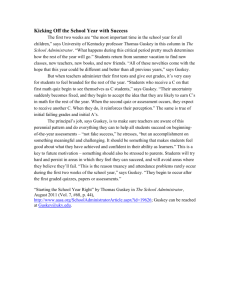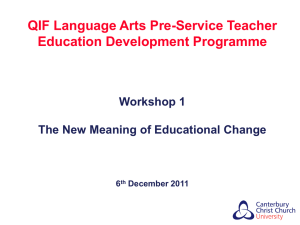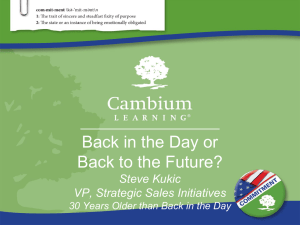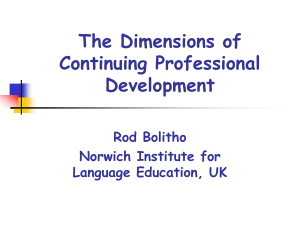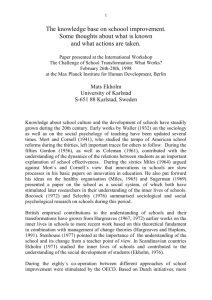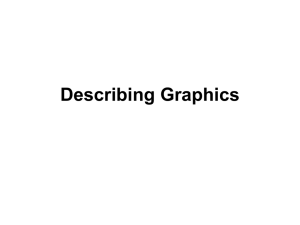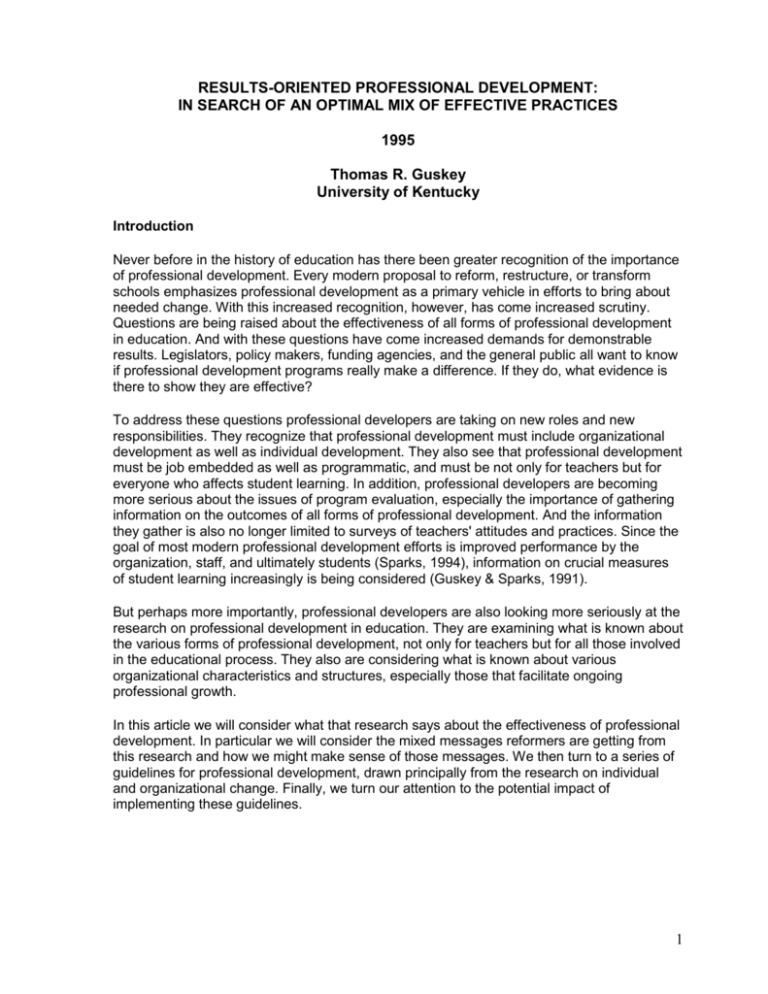
RESULTS-ORIENTED PROFESSIONAL DEVELOPMENT:
IN SEARCH OF AN OPTIMAL MIX OF EFFECTIVE PRACTICES
1995
Thomas R. Guskey
University of Kentucky
Introduction
Never before in the history of education has there been greater recognition of the importance
of professional development. Every modern proposal to reform, restructure, or transform
schools emphasizes professional development as a primary vehicle in efforts to bring about
needed change. With this increased recognition, however, has come increased scrutiny.
Questions are being raised about the effectiveness of all forms of professional development
in education. And with these questions have come increased demands for demonstrable
results. Legislators, policy makers, funding agencies, and the general public all want to know
if professional development programs really make a difference. If they do, what evidence is
there to show they are effective?
To address these questions professional developers are taking on new roles and new
responsibilities. They recognize that professional development must include organizational
development as well as individual development. They also see that professional development
must be job embedded as well as programmatic, and must be not only for teachers but for
everyone who affects student learning. In addition, professional developers are becoming
more serious about the issues of program evaluation, especially the importance of gathering
information on the outcomes of all forms of professional development. And the information
they gather is also no longer limited to surveys of teachers' attitudes and practices. Since the
goal of most modern professional development efforts is improved performance by the
organization, staff, and ultimately students (Sparks, 1994), information on crucial measures
of student learning increasingly is being considered (Guskey & Sparks, 1991).
But perhaps more importantly, professional developers are also looking more seriously at the
research on professional development in education. They are examining what is known about
the various forms of professional development, not only for teachers but for all those involved
in the educational process. They also are considering what is known about various
organizational characteristics and structures, especially those that facilitate ongoing
professional growth.
In this article we will consider what that research says about the effectiveness of professional
development. In particular we will consider the mixed messages reformers are getting from
this research and how we might make sense of those messages. We then turn to a series of
guidelines for professional development, drawn principally from the research on individual
and organizational change. Finally, we turn our attention to the potential impact of
implementing these guidelines.
1
Research on Professional Development
The research base on professional development in education is quite extensive. For the most
part, however, this research has documented the inadequacies of professional development
and, occasionally, proposed solutions (Epstein, Lockard, & Dauber, 1988; Griffin, 1983;
Guskey, 1986; Joyce & Showers, 1988; Lieberman & Miller, 1979; Orlich, 1989; Wood &
Thompson, 1980, 1993). Still, reformers attempting to make sense of these various solutions
quickly find themselves faced with seemingly incompatible dichotomies. For instance:
Some researchers suggest that professional development efforts designed to facilitate
change must be practitioner specific and focus principally on day-to-day activities at
the classroom level (McLaughlin, 1990; Weatherley & Lipsky, 1977; Wise, 1991).
Others indicate that an emphasis on individuals is detrimental to progress and more
systemic or organizational approaches are necessary (Tye & Tye, 1984; Waugh &
Punch, 1987).
Some experts stress that reforms in professional development must be initiated and
carried out by individual teachers and school-based personnel (Joyce, McNair, Diaz,
& McKibbin, 1976; Lambert, 1988; Lawrence, 1974; Massarella, 1980). Others
emphasize the most successful programs are those guided by a clear vision that sees
beyond the walls of individual classrooms and schools, since teachers and schoolbased individuals generally lack the capacity to conceive and implement worthwhile
improvements on their own (Barth, 1991; Clune, 1991; Mann, 1986; Wade, 1984).
Some reviewers argue the most effective professional development efforts approach
change in a gradual and incremental fashion, not expecting too much at one time
(Doyle & Ponder, 1977; Fullan, 1985; Mann, 1978; Sparks, 1983). Others insist the
broader the scope of a professional development program, the more effort required of
teachers, and the greater the overall change in teaching style attempted, the more
likely the program is to elicit the enthusiasm of teachers and to be implemented well
(Berman & McLaughlin, 1978; McLaughlin & Marsh, 1978).
These and other similar dichotomies in the professional development literature leave
reformers feeling confused. Many question how they can be expected to design and
implement successful professional development when even researchers and experts in the
field cannot agree on what should be done. While the critical issues seem clear, positive
solutions remain illusive. As a result, reformers struggle desperately in their attempts to
address educators' many and highly diverse professional development needs.
The Search For An Optimal Mix
The problem in trying to identify the critical elements of successful professional development
is that most efforts focus on a search for "one right answer." They begin by gathering
evidence from a variety of studies, investigations, and program evaluations. This evidence is
then synthesized to distinguish those characteristics that consistently relate to some measure
of effectiveness. The modern technique used by many researchers to conduct such
syntheses is called "meta-analysis" (Hedges & Olkin, 1985). This technique allows the
researcher to standardize and then average the effect sizes across studies. In most cases,
effectiveness is judged by an index of participants' satisfaction with the program or some
indication of change in their professional knowledge. Rarely is change in professional
practice considered, and rarer still is any assessment of impact on student learning (Guskey
2
& Sparks, 1991). What typically results are prescriptions of general practices that are
described in broad and nebulous terms. Sadly, these prescriptions offer little guidance to
practically minded reformers who want to know precisely what to do and how to do it.
What is neglected in nearly all of these efforts is the powerful impact of context. In fact,
synthesizing the evidence across studies is done specifically to eliminate the effects of
context, or to decontextualize the data. Yet as Clark, Lotto, and Astuto (1984); Firestone and
Corbett (1987); Fullan (1985); Huberman and Miles (1984); and others suggest, the
uniqueness of the individual setting will always be a critical factor in education. What works in
one situation may not work in another . Although some general principles may apply
throughout, most will need to be adapted, at least in part, to the unique characteristics of that
setting.
Businesses and industries operating in different parts of the country or in different regions
around the world may successfully utilize identical processes to produce the same quality
product. But reforms based upon assumptions of uniformity in the educational system
repeatedly fail (Elmore & McLaughlin, 1988). The teaching and learning process is a complex
endeavor that is embedded in contexts that are highly diverse. This combination of
complexity and diversity makes it difficult, if not impossible, for researchers to come up with
universal truths (Guskey, 1993; Huberman, 1983, 1985).
We know with certainty that reforms in education today succeed to the degree that they adapt
to and capitalize on this variability. In other words, they must be shaped and integrated in
ways that best suit regional, organizational, and individual contexts: the local values, norms,
policies, structures, resources, and processes (Griffin & Barnes, 1984; McLaughlin, 1990;
Talbert, McLaughlin, & Rowan, 1993).
Recognizing the importance of contextual differences compels professional developers to
consider more seriously the dynamics of systemic change and the power of systems.
Contexts involve organizations which must develop along with the individuals within them.
In addition, recognizing the importance of contextual differences brings clarity to the nature of
the dichotomies described earlier. That is, successful change efforts in some contexts require
professional development that focuses on practitioner specific activities (Porter, 1986; Wise,
1991), while other contexts demand a more systemic or organizational approach (Sarason,
1990). In some contexts teacher initiated efforts work best (Weatherley & Lipsky, 1977), while
in others a more administratively directed approach may be needed (Mann, 1986). And while
some contexts demand that professional development take a gradual approach to change
(Sparks, 1983), others require immediate and drastic alterations at all levels of the
organization (McLaughlin, 1990).
Acknowledging the powerful influence of context also shows the futility of the search for "one
right answer." Because of the enormous variability in educational contexts, there will never
be "one right answer." Instead, there will be a collection of answers, each specific to a
context. Our search must focus, therefore, on finding the optimal mix -- that assortment of
professional development processes and technologies that will work best in a particular
setting.
It is also important to recognize that the optimal mix for a particular setting changes over
time. Contexts, like the people who shape them, are dynamic. They change and adapt in
response to a variety of influences. Some of these influences may be self-initiated while
3
others are environmentally imposed. Because of this dynamic nature, the optimal mix for a
particular context evolves over time, changing as various aspects of the context change.
What works today may be quite different from what worked five years ago, but it also is likely
to be different from what will work five years hence.
Guidelines for Success
Because of the powerful and dynamic influence of context, it is impossible to make precise
statements about the elements of effective professional development. Even programs that
share a common vision and seek to attain comparable goals may need to follow very different
pathways to succeed. The best that can be offered are procedural guidelines that appear to
be critical to the professional development process. These guidelines are derived from
research on professional development specifically and the change process generally
(Crandall et al., 1982; Fullan, 1991; Guskey, 1986; Huberman & Miles, 1984; Prochaska,
DiClemente, & Norcross, 1992; McLaughlin, 1990). Rather than representing strict
requirements, however, these guidelines reflect a framework for developing that optimal mix
of professional development processes and technologies that will work best in a specific
context at a particular point in time.
In reviewing these guidelines it is important to keep in mind that at present we know far more
about professional development processes that fail than we do about those that succeed
(Gall & Renchler, 1985; Showers, Joyce, & Bennett, 1987). There is no guarantee, therefore,
that following these guidelines will always bring success. Still, substantial evidence indicates
that neglecting the issues described in these guidelines at best will limit success and, at
worst, will result in programs and activities that fail to bring about significant or enduring
change.
Guideline #1: Recognize Change as Both an Individual and Organizational Process
An important lesson learned from the past is that we cannot improve schools without
improving the skills and abilities of the professional educators within them. In other words, we
must see change as an individual process and be willing to invest in the intellectual capital of
those individuals who staff our schools (Wise, 1991). Success in any improvement effort
always hinges on the smallest unit of the organization and, in education, that is the classroom
(McLaughlin, 1991). School principals and teachers are the ones chiefly responsible for
implementing change. Therefore professional development processes, regardless of their
form (Sparks & Loucks-Horsley, 1989), must be relevant to principals and teachers, and must
directly address their specific needs and concerns (Hall & Loucks, 1978; Weatherley &
Lipsky, 1977).
At the same time, to see change as only an individual process can make professional
development an arduous and uncomfortable personal endeavor. Even changes that are
empowering bring a certain amount of anxiety. And principals and teachers, like
professionals in many fields, are reluctant to adopt new practices or procedures unless they
feel sure they can make them work (Lortie, 1975). To change or to try something new means
to risk failure, and that is both highly embarrassing and threatening to one's sense of
professional pride (Pejouhy, 1990).
Furthermore, it is important to keep in mind that organizations, like individuals, also adopt
change (Sarason, 1982; Shroyer, 1990; Waugh & Punch, 1987). To focus exclusively on
individuals in professional development efforts, while neglecting factors such as
4
organizational features and system politics, severely limits the likelihood of success (Berman,
1978; Clift, Holland, & Veal, 1990; Deal, 1987; Fullan & Pomfret, 1977; Parker, 1980). A
debilitating environment can squash any change effort, no matter how much we exhort
individuals to persist (Beane, 1991).
To focus on change as only an organizational matter, however, is equally ineffective. Fiddling
with the organizational structure is a favorite device of educational policy makers and
administrators because it communicates to the public in a symbolic way that they are
concerned with the performance of the system. But as Elmore (1992) argues, evidence is
scant that such structural change leads in any reliable way to changes in how teachers teach,
what they teach, or how students learn. McLaughlin (1990) describes this as the difference
between macro-level concerns and micro-level realities. To facilitate change we must look
beyond policy structures and consider the embedded structure that most directly affects the
actions and choices of the individuals involved.
The key is to find the optimal mix of individual and organizational processes that will
contribute to success in a particular context. In some situations, individual initiative and
motivation might be quite high, but organizational structures stand in the way of significant
improvement. Teachers may wish to plan collaboratively, for example, but find it impossible
to do so because of the inordinate time demands of their teaching schedules. In other
situations, progressive and supportive organizational structures may be in place, but the lack
of personal incentives for collaboration and experimentation inhibits any meaningful change
in classroom practice. Viewing change as both an individual and organizational process that
must be adapted to contextual characteristics will help clarify the steps necessary for success
in professional development.
Guideline #2: Think Big, but Start Small
There is no easier way to sabotage change efforts than to take on too much at one time. In
fact, if there is one truism in the vast research literature on change it is that the magnitude of
change persons are asked to make is inversely related to their likelihood of making it
(Guskey, 1991). Professionals at all levels generally oppose radical alterations to their
present procedures. Hence the probability of their implementing a new program or innovation
depends largely on their judgment of the magnitude of change required for implementation
(Doyle & Ponder, 1977; Fullan, 1982; Mann, 1978).
Successful professional development programs are those that approach change in a gradual
and incremental fashion. Efforts are made to illustrate how the new practices can be
implemented in ways that are not too disruptive or require a great deal of extra work (Sparks,
1983). If a new program does require major changes be made, it is best to ease into its use
rather than expect comprehensive implementation at once (Fullan, 1985).
But while the changes advocated in a professional development effort must not be so
ambitious that they require too much too soon from the implementation system, they need to
be sufficient in scope to challenge professionals and kindle interest (McLaughlin, 1990).
Crandall, Eisemann, and Louis (1986) argue that the greatest success is likely when the size
of the change is not so massive that typical users find it necessary to adopt a coping strategy
that seriously distorts the change, but large enough to require noticeable, sustained effort.
Modest, narrowly conceived projects seldom bring about significant improvement. This is
what is meant by "think big."
5
The key, again, is to find the optimal mix. Professional development efforts should be
designed with long term goals based on a grand vision of what is possible. A program might
seek to have all students become successful learners, for example. At the same time, that
vision should be accompanied by a strategic plan that includes specific incremental goals for
three to five years into the future, gradually expanding on what is successful in that context
and offering support to those engaged in the change (Fullan, 1992; Louis & Miles, 1990).
Guideline #3: Work in Teams to Maintain Support
The discomfort that accompanies change is greatly compounded if the individuals involved
perceive they have no say in the process or if they feel isolated and detached in their
implementation efforts. For this reason it is imperative that all aspects of professional
development be fashioned to involve teams of individuals working together. This means that
planning, implementation, and follow-up activities should all be seen as joint efforts, providing
opportunities for those with diverse interests and responsibilities to offer their input and
advice (Massarella, 1980).
To insure that the teams function well and garner broad-based support for professional
development efforts, it is important they involve individuals from all levels of the organization.
In school improvement programs, for example, the best professional development teams
include teachers, non-instructional staff members, building and central office administrators
(Caldwell & Wood, 1988). In some contexts the involvement of parents and community
members also can be helpful (Lezotte, 1989). Although the roles and responsibilities of these
individuals in the professional development process will be different, all have valuable
insights and expertise to offer.
Still, the notion of teamwork must be balanced. There is evidence to show, for instance, that
large-scale participation during the early stages of a change effort is sometimes
counterproductive (Huberman & Miles, 1984). Elaborate needs assessments, endless
committee and task force debates, and long and tedious planning sessions often create
confusion and alienation in the absence of any action. Extensive planning can also exhaust
the energy needed for implementation, so that by the time change is to be enacted, people
are burned out (Fullan, 1991). Furthermore, broad-based participation in many decisions is
not always essential or possible on a large scale (Dawson, 1981; Hood & Blackwell, 1980).
As Little (1989) argues, there is nothing particularly virtuous about teamwork or collaboration
per se. It can serve to block change or inhibit progress just as easily as it can serve to
enhance the process.
To facilitate change, teamwork must be linked to established norms of continuous
improvement and experimentation, and these norms then guide professional development
efforts. In other words, there must be a balance of teamwork and collaboration with the
expectation that all involved in the process -- teachers, administrators, and non-instructional
staff members -- are constantly seeking and assessing potentially better practices (Little,
1989). Such a balance promotes collegial interaction and acknowledges the naturally
occurring relationships among professionals.
The most successful professional development efforts, for example, are those that provide
regular opportunities for participants to share perspectives and seek solutions to common
problems in an atmosphere of collegiality and professional respect (Fullan, Bennett, &
Rolheiser-Bennett, 1989; Little, 1982). Working in teams also allows tasks and
responsibilities to be shared. This not only reduces the workload of individual team members,
6
it also enhances the quality of the work produced. Additionally, working in teams helps focus
attention on the shared purposes and improvement goals that are the basis of the
professional development process in that context (Leithwood & Montgomery, 1982;
Rosenholtz, 1987; Stevenson, 1987).
Guideline #4: Include Procedures for Feedback on Results
If the use of new practices is to be sustained and changes are to endure, the individuals
involved need to receive regular feedback on the effects of their efforts. It is well known that
successful actions are reinforcing and likely to be repeated while those that are unsuccessful
tend to be diminished. Similarly, practices that are new and unfamiliar will be accepted and
retained when they are perceived as increasing one's competence and effectiveness. This is
especially true of teachers, whose primary psychic rewards come from feeling certain about
their capacity to affect student growth and development (Bredeson, Fruth, Kasten, 1983;
Guskey, 1989; Huberman, 1992). New practices are likely to be abandoned, however, in the
absence of any evidence of their positive effects. Hence specific procedures to provide
feedback on results are essential to the success of any professional development effort.
Personal feedback on results can be provided in a variety of ways, depending on the context.
In professional development programs involving the implementation of mastery learning
(Bloom, 1968, 1971), for example, teachers receive this feedback from their students through
regular formative assessments (Bloom, Madaus, & Hastings, 1981). In mastery learning
classrooms, formative assessments are used to provide students with detailed feedback on
their learning progress and to diagnose learning problems. As such, they can take many
forms, including writing samples, skill demonstrations, projects, reports, performance tasks,
or other, more objective assessment devices such as quizzes or tests. These assessments
are then paired with corrective activities designed to help students remedy any learning
errors identified through the assessment.
But in addition to the feedback they offer students, formative assessments also offer teachers
specific feedback on the effectiveness of their application of mastery learning. These regular
checks on student learning provide teachers with direct evidence of the results of their
teaching efforts. They illustrate what improvements have been made and where problems
still exist. This information then can be used to guide revisions in the instructional process so
that even greater gains are achieved (Guskey, 1985).
Of course, results from assessments of student learning are not the only type of personal
feedback that teachers find meaningful. Brophy and Good (1974) discovered that providing
feedback to teachers about their differential treatment of students resulted in significant
change in their interactions with students. Information on increased rates of student
engagement during class sessions and evidence of improvements in students' sense of
confidence or self-worth also have been shown to be powerful in reinforcing the use of new
instructional practices (Dolan, 1980; Stallings, 1980). Information from informal assessments
of student learning and moment-to-moment responses during instruction can provide a basis
for teachers to judge the effectiveness of alternative techniques as well (Fiedler, 1975;
Green, 1983; Smylie, 1988).
Yet despite its importance, procedures for gathering feedback on results must be balanced
with other concerns. The methods used to obtain feedback, for example, must not be
disruptive of instructional procedures. Furthermore, they should not require inordinate
amounts of time or extra work from those engaged in the difficult process of implementation.
7
Timing issues are also critical, for it is unfair to expect too much too soon from those involved
in implementation. As Loucks-Horsley, Harding, Arbuckle, Murray, Dubea, and Williams
(1987) point out, this is analogous to pulling a plant out of the ground each day to check its
roots for growth. In other words, there must be a balance, or optimal mix, in which the need
for feedback is adapted to the characteristics of the program and the setting. Feedback
procedures must focus on outcomes that are meaningful to the professionals involved, but
also timed to best suit program needs and the constraints of the context.
Guideline #5: Provide Follow-Up, Support, and Pressure
Few persons can move from a professional development experience directly into
implementation with success. In fact, few will even venture into the uncertainty of
implementation unless there is an appreciation of the difficulties that are a natural part of the
process (Fullan & Miles, 1992). There also must be a threshold level of "readiness" for the
change. Fitting new practices and techniques to unique on-the-job conditions is an uneven
process that requires time and extra effort, especially when beginning (Berman &
McLaughlin, 1978; Joyce and Showers, 1980). Guidance, direction, and support with
pressure are crucial when these adaptations are being made (Baldridge & Deal, 1975; Fullan,
1991; Parker, 1980; Waugh & Punch, 1987).
What makes the early stages of implementation so complicated is that the problems
encountered at this time are often multiple, pervasive, and unanticipated. Miles and Louis
(1990) point out that developing the capacity to deal with these problems promptly, actively,
and in some depth may be "the single biggest determinant of program success" (p. 60). And
regardless of how much advanced planning or preparation takes place in an effort to
establish readiness, it is when professionals actually implement the new ideas or practices
that they have the most specific problems and doubts (Berman, 1978; Fullan & Pomfret,
1977).
Support coupled with pressure at this time are vital for continuation. Support allows those
engaged in the difficult process of implementation to tolerate the anxiety of occasional
failures. Pressure is often necessary to initiate change among those whose self-impetus for
change is not great (Airasian, 1987; Huberman & Crandall, 1983). In addition, it provides the
encouragement, motivation, and occasional nudging that many practitioners require to persist
in the challenging tasks that are intrinsic to all change efforts.
Of all aspects of professional development, this is perhaps the most neglected. It makes
clear that to be successful, professional development must be seen as a process, not an
event (Loucks-Horsley, et al. 1987). Learning to be proficient at something new or finding
meaning in a new way of doing things is difficult and sometimes painful. Furthermore, any
change that holds great promise for increasing individuals' competence or enhancing an
organization's effectiveness is likely to be slow and require extra work (Huberman & Miles,
1984). It is imperative, therefore, that improvement be seen as a continuous and ongoing
endeavor (McLaughlin & Marsh, 1978).
If a new program or innovation is to be implemented well, it must become a natural part of
practitioners' repertoire of professional skills and built into the normal structures and practices
of the organization (Fullan & Miles, 1992; Miles & Louis, 1987). For advances to be made
and professional improvements to continue, the new practices and techniques that were the
focus of the professional development effort must become used almost out of habit. And for
8
this to occur, continued support and encouragement, paired with subtle pressure to persist,
are essential.
This crucial support with pressure can be offered in a variety of ways. McLaughlin and Marsh
(1978) recommend that local resource personnel or consultants be available to provide online assistance when difficulties arise. They emphasize, however, that the quality of the
assistance is critical, and that it is better to offer no assistance than poor or inappropriate
assistance. Joyce and Showers (1988), suggest that support for change take the form of
coaching -- providing practitioners with technical feedback, guiding them in adapting the new
practices to their unique contextual conditions, helping them to analyze the effects of their
efforts, and urging them to continue despite minor setbacks. In other words, coaching is
personal, practical, on-the-job assistance, that can be provided by consultants,
administrators, directors, peers, or other professional colleagues. Simply offering
opportunities for practitioners to interact and share ideas with each other also can be
valuable (Massarella, 1980; McLaughlin & Marsh, 1978).
Here again, the notion of balance is critical. In some contexts a substantial amount of
pressure from leaders may be necessary to overcome inertia, recalcitrance, or outright
resistance (Mann, 1986). It is possible, for example, when making decisions about
instructional practices to overemphasize teachers' personal preferences and
underemphasize concern about student learning (Buchmann, 1986). Yet in contexts where
there is considerable individual initiative, such pressure may be seen as a strong-armed
tactic and unprofessional (Leiter & Cooper, 1978). The key is to find the optimal mix for that
context, understanding well the interpersonal dynamics of the individuals involved and the
culture of the organization in which they work.
Guideline #6: Integrate Programs
More so than any other profession, education seems fraught with innovation. In fact,
innovations seem to come and go in education about as regularly as the seasons change.
Each year new programs are introduced in schools without any effort to show how they relate
to the ones that came before or those that may come afterward. Furthermore, there is seldom
any mention of how these various innovations contribute to a growing professional
knowledge base. The result is an enormous overload of fragmented, uncoordinated, and
ephemeral attempts at change (Fullan & Miles, 1992).
The steady stream of innovations in education causes many practitioners to view all new
programs as isolated fads that will soon be gone, only to be replaced by yet another
bandwagon (Latham, 1988). This pattern of constant yet unrelated, short-term innovations
not only obscures improvement and provokes cynicism, it also imposes a sense of affliction.
Having seen a multitude of innovations come into and go out of fashion, veteran teachers
frequently calm the fears of their less experienced colleagues who express concern about
implementing a new program with the advice, "Don't worry; this, too, shall pass."
If professional development efforts that focus on the implementation of new innovations are
to succeed, they must include precise descriptions of how these innovations can be
integrated. That is, each new innovations must be presented as part of a coherent framework
for improvement. It is difficult enough for practitioners to learn the particular features of one
innovation, let alone to figure out how it can be combined with others. And because no single
innovation is totally comprehensive, implementing only one will leave many problems
unresolved. It is only when several strategies are carefully and systematically integrated that
9
substantial improvements become possible. Doyle (1992), Sarason (1990), and others also
emphasize that coordinating programs and combining ideas releases great energy in the
improvement process.
In recent years several insightful researchers have described how different combinations of
innovations can yield impressive results (e.g. Arredondo & Block, 1990; Davidson & O'Leary,
1990; Guskey, 1988, 1990a; Mevarech, 1985; Weber, 1990). In addition, several frameworks
for integrating a collection of programs or innovations have been developed that practitioners
are finding especially useful. One example is a framework developed by Marzano, Pickering,
and Brandt (1990) based on various dimensions of learning. Another developed by Guskey
(1990b) is built around five major components in the teaching and learning process. These
frameworks allow skilled practitioners to see more clearly the linkages among various
innovations. They also offer guidance to the efforts of seriously minded reformers seeking to
pull together programs that collectively address the problems that are most pressing in a
particular context.
A crucial point here is that the particular collection of programs or innovations that is best
undoubtedly will vary from setting to setting. As a result, the way linkages are established
and applications integrated will need to vary as well. Fullan (1992) stresses that, "schools are
not in the business of managing single innovations; they are in the business of contending
with multiple innovations simultaneously" (p. 19). By recognizing the dimensions of learning a
particular innovation stresses or the components of the teaching and learning process it
emphasizes, savvy educators can pull together innovations that collectively address what is
most needed in that context at a particular point in time.
Conclusion
The ideas presented in these procedural guidelines are not new and certainly cannot be
considered revolutionary. They may, in fact, appear obvious to those with extensive
experience in professional development processes. Yet as self-evident as they may seem, it
is rare to find a professional development effort today that is designed and implemented with
thorough attention to these guidelines or the factors that underlie them. It is rarer still to find
professional development endeavors that evaluate the implementation of these guidelines in
terms of effects on student learning.
What is evident from these guidelines is that the key to greater success in professional
development rests not so much in the discovery of new knowledge, but in our capacity to use
deliberately and wisely the knowledge we have. This is true regardless of whether
professional development is viewed as an integral part of one's career cycle, as a selfdirected journey to find meaning and appreciation in one's work, or as a structured effort to
keep professionals abreast of advances in their field. To develop this capacity requires a
clear vision of our goals and a thorough understanding of the process by which those goals
can be attained.
In the minds of many today there is a clear vision of what would be ideal in professional
development. That ideal sees educators at all levels constantly in search of new and better
ways to address the diverse learning needs of their students. It sees schools as learning
communities where teachers and students are continually engaged in inquiry and stimulating
discourse. It sees practitioners in education respected for their professional knowledge and
pedagogic skill. The exact process by which that vision can be accomplished, however, is
much more blurred and confused. The reason, as argued here, is that the process is so
10
highly contextualized. There is no "one right answer" or "one best way." Rather, there are a
multitude of ways, all adapted to the complex and dynamic characteristics of specific
contexts. Success, therefore, rests in finding the optimal mix of process elements and
technologies that then can be carefully, sensibly, and thoughtfully applied in a particular
setting.
While it is true that the ideas presented here offer an optimistic perspective on the potential of
professional development in education, these ideas are not far-fetched. They illustrate that
although the process of change is difficult and complex, we are beginning to understand how
to facilitate that process through pragmatic adaptations to specific contexts so that ongoing
professional growth and improved professional practice are ensured. Doing so is essential to
improved learning for all students.
References
Airasian, P. W. (1987). State mandated testing and educational reform: Context and
consequences. American Journal of Education, 95, 393-412.
Arredondo, D. E., & Block, J. H. (1990). Recognizing the connections between thinking skills
and mastery learning. Educational Leadership, 47(5), 4-10.
Baldridge, J. V., & Deal, T. (1975). Managing change in educational organizations. Berkeley,
CA: McCutchan.
Barth, R. S. (1991). Restructuring schools: Some questions for teachers and principals. Phi
Delta Kappan, 73(2), 123-128.
Beane, J. A. (1991). Sorting out the self-esteem controversy. Educational Leadership, 49(1),
25-30.
Berman, P. (1978). The study of macro- and micro-implementation. Public Policy, 26(2), 157184.
Berman, P., & McLaughlin, M. W. (1978). Federal programs supporting educational change.
Vol. VIII: Implementing and sustaining innovations. Santa Monica, CA: Rand Corporation.
Bloom, B. S. (1968). Learning for mastery. Evaluation Comment, 1(2), 1-12.
Bloom, B. S. (1971). Mastery learning. In J. H. Block (Ed.), Mastery learning: Theory and
practice (pp. 47-63). New York: Holt, Rinehart & Winston.
Bloom, B. S., Madaus, G. F., & Hastings, J. T. (1981). Evaluation to improve learning. New
York: McGraw-Hill.
Bredeson, P. V., Fruth, M. J., & Kasten, K. L. (1983). Organizational incentives and
secondary school teaching. Journal of Research and Development in Education, 16, 24-42.
11
Brophy, J. E., & Good, T. L. (1974). Teacher-student relationships: Causes and
consequences. New York: Holt, Rinehart & Winston.
Buchmann, M. (1986). Role over person: Morality and authenticity in teaching. Teachers
College Record, 87, 529-543.
Burden, P. R. (Ed.). (1990). Teacher induction [entire issue]. Journal of Staff Development,
11(4).
Caldwell, S., & Wood, F. (1988). School-based improvement -- Are we ready? Educational
Leadership, 46(2), 50-53.
Clark, D., Lotto, S., & Astuto, T. (1984). Effective schools and school improvement: A
comparative analysis of two lines of inquiry. Educational Administration Quarterly, 20(3), 4168.
Clift, R. T., Holland, P. E., & Veal, M. L. (1990). School context dimensions that affect staff
development. Journal of Staff Development, 11(1), 34-38.
Clune, W. H. (1991). Systemic educational policy. Madison, WI: Wisconsin Center for
Educational Policy, University of Wisconsin - Madison.
Crandall, D. P., Loucks-Horsley, S., Bauchner, J. E., Schmidt, W. B., Eiseman, J. W., Cox, P.
L., Miles, M. B., Huberman, A. M., Taylor, B. L., Goldberg, J. A., Shive, G., Thompson, C. L.,
& Taylor, J. A. (1982). People, policies, and practices: Examining the chain of school
improvement. Andover, MA: The NETWORK, Inc.
Crandall, D., Eiseman, J., & Louis, K. (1986). Strategic planning issues that bear on the
success of school improvement efforts. Educational Administration Quarterly, 22(3), 21-53.
Davidson, N., & O'Leary, P. W. (1990). How cooperative learning can enhance mastery
teaching. Educational Leadership, 47(5), 30-34.
Dawson, J. (1981). Teacher participation in educational innovation: Some insights into its
nature. Philadelphia, PA: Research for Better Schools.
Deal, T. (1987). The culture of schools. In L. Sheive & M. Schoeheit (Eds.), Leadership:
Examining the elusive (pp. 3-15). Alexandria, VA: Association for Supervision and Curriculum
Development.
Dolan, L. J. (1980). The affective correlates of home support, instructional quality, and
achievement. Unpublished doctoral dissertation, University of Chicago.
Doyle, D. P. (1992). The challenge, the opportunity. Phi Delta Kappan, 73(7), 512-520.
Doyle, W. & Ponder, G. (1977). The practical ethic and teacher decision-making.
Interchange, 8(3), 1-12.
Elmore, R. F. (1992). Why restructuring alone won't improve teaching. Educational
Leadership, 49(7), 44-48.
12
Elmore, R. F., & McLaughlin, M. W. (1988). Steady work: Policy, practice, and reform in
American education (R-3574-NIE/RC). Santa Monica, CA: Rand Corporation.
Epstein, J. L., Lockard, B. L., & Dauber, S. L. (1988). Staff development policies needed in
the middle grades. Paper presented at the annual meeting of the American Educational
Research Association, New Orleans, LA.
Fiedler, M. (1975). Bidirectionality of influence in classroom interaction. Journal of
Educational Psychology, 67, 735-744.
Firestone, W., & Corbett, H. D. (1987). Planned organizational change. In N. Boyand (Ed.),
Handbook of research on educational administration (pp. 321-340). New York: Longman.
Floden, R. E., & Clark, C. M. (1988). Preparing teachers for uncertainty. Teachers College
Record, 89, 505-524.
Fullan, M. G. (1982). The meaning of educational change. New York: Teachers College
Press.
Fullan, M. G. (1985). Change processes and strategies at the local level. Elementary School
Journal, 85, 391-421.
Fullan, M. G. (1990). Staff development, innovation, and institutional development. In B.
Joyce (Ed.), Changing school culture through staff development: 1990 yearbook of the
Association for Supervision and Curriculum Development (pp. 3-25). Alexandria, VA:
Association for Supervision and Curriculum Development.
Fullan, M. G. (1991). The new meaning of educational change. New York: Teachers College
Press.
Fullan, M. G. (1992). Visions that blind. Educational Leadership, 49(5), 19-20.
Fullan, M. G., Bennett, B., & Rolheiser-Bennett, C. (1989). Linking classroom and school
improvement. Paper presented at the annual meeting of the American Educational Research
Association, San Francisco, CA.
Fullan, M. G., & Miles, M. B. (1992). Getting reform right: What works and what doesn't. Phi
Delta Kappan, 73(10), 745-752.
Fullan, M., & Pomfret, A. (1977). Research on curriculum and instruction implementation.
Review of Educational Research, 27(2), 355-397.
Gall, M. D., & Renchler, R. S. (1985). Effective staff development for teachers: A researchbased model. Eugene, OR: ERIC Clearinghouse on Educational Management, University of
Oregon.
Green, J. (1983). Research on teaching as a linguistic process: A state of the art. In E.
Gordon (Ed.), Review of research in education (Vol. 10, pp. 151-252.). Washington, DC:
American Educational Research Association.
13
Griffin, G. A. (Ed.) (1983). Staff development. Eighty-second yearbook of the National Society
for the Study of Education. Chicago: University of Chicago Press.
Griffin, G. A., & Barnes, S. (1984). School change: A craft-derived and research-based
strategy. Teachers College Record, 86, 103-123.
Guskey, T. R. (1985). Implementing mastery learning. Belmont, CA: Wadsworth.
Guskey, T. R. (1986). Staff development and the process of teacher change. Educational
Researcher, 15(5), 5-12.
Guskey, T. R. (1988). Mastery learning and mastery teaching: How they complement each
other. Principal, 68(1), 6-8.
Guskey, T. R. (1989). Attitude and perceptual change in teachers. International Journal of
Educational Research, 13(4), 439-453.
Guskey, T. R. (1990a). Cooperative mastery learning strategies. Elementary School Journal,
91(1), 33-42.
Guskey, T. R. (1990b). Integrating innovations. Educational Leadership, 47(5), 11-15.
Guskey, T. R. (1991). Enhancing the effectiveness of professional development programs.
Journal of Educational and Psychological Consultation, 2(3), 239-247.
Guskey, T. R. (1992, November). What does it mean to be "research-based"? The
Developer, p. 5.
Guskey, T. R. (1993, February). Why pay attention to research if researchers can't agree?
The Developer, pp. 3-4.
Guskey, T. R., & Sparks, D. (1991). What to consider when evaluating staff development.
Educational Leadership, 49(3), 73-76.
Hall, G. E., & Loucks, S. (1978). Teachers concerns as a basis for facilitating and
personalizing staff development. Teachers College Record, 80, 36-53.
Hedges, L. V., & Olkin, I. (1985). Statistical methods for meta-analysis. Orlando, FL:
Academic Press.
Hood, P., & Blackwell, L. (1980). The role of teachers and other school practitioners in
decision making and innovations. San Francisco: Far West Laboratory.
Huberman, M. (1983). Recipes for busy teachers. Knowledge: Creation, diffusion, utilization,
4, 478-510.
Huberman, M. (1985). What knowledge is of most worth to teachers? A knowledge-use
perspective. Teaching and teacher education, 1, 251-262.
14
Huberman, M. (1992). Teacher development and instructional mastery. In A. Hargreaves &
M. G. Fullan (Eds.), Understand teacher development (pp. 122-142). New York: Teachers
College Press.
Huberman, M., & Crandall, D. (1983). People, Policies and practice: Examining the chain of
school improvement. Vol. 9. Implications for action: A study of dissemination efforts
supporting school improvement. Andover, MA: The Network.
Huberman, M., & Miles, M. B. (1984). Innovation up close: How school improvement works.
New York: Plenum.
Joyce, B., & Showers, B. (1980). Improving inservice training: The messages of research.
Educational Leadership, 37(5), 379-385.
Joyce, B., & Showers, B. (1983). Power in staff development through research on training.
Arlington, VA: Association for Supervision and Curriculum Development.
Joyce, B., & Showers, B. (1988). Student achievement through staff development. New York:
Longman.
Joyce, B., McNair, K. M., Diaz, R., & McKibbin, M. D. (1976). Interviews: Perceptions of
professionals and policy makers. Stanford, CA: Stanford Center for Research and
Development in Teaching, Stanford University.
Lambert, L. (1988). Staff development redesigned. Educational Leadership, 45(8), 665-668.
Latham, G. (1988). The birth and death cycles of educational innovations. Principal, 68(1),
41-43.
Lawrence, G. (1974). Patterns of effective inservice education: A state of the art summary of
research on materials and procedures for changing teacher behavior in inservice education.
Tallahassee, FL: Florida State Department of Education.
Leiter, M., & Cooper, M. (1978). How teacher unionists view inservice education. Teachers
College Record, 80, 107-125.
Leithwood, K. & Montgomery, D. (1982). The role of the elementary school principal in
program improvement. Review of Educational Research, 52, 309-339.
Lezotte, L. W. (1989). The open book. Focus in Change, 1(2), 3.
Lieberman, A., & Miller, L. (1979). Staff development: New demands, new realities, new
perspectives. New York: Teachers College Press.
Little, J. W. (1982). Norms of collegiality and experimentation: Workplace conditions of school
success. American Educational Research Journal, 19, 325-340.
Little, J. W. (1989). The persistence of privacy: Autonomy and initiative in teachers'
professional relations. Paper presented at the annual meeting of the American Educational
Research Association, San Francisco.
15
Lortie, D. C. (1975). Schoolteacher: A sociological study. Chicago: University of Chicago
Press.
Loucks-Horsley, S., Harding, C. K., Arbuckle, M. A., Murray, L. B., Dubea, C., Williams, M. K.
(1987). Continuing to learn: A guidebook for teacher development. Andover, MA: Regional
Laboratory for Educational Improvement of the Northeast & Islands.
Louis, K. S., & Miles, M. B. (1990). Improving the urban high school: What works and why.
New York: Teachers College Press.
Mann, D. (1978). The politics of training teachers in schools. In D. Mann (Ed.), Making
change happen (pp. 3-18). New York: Teachers College Press.
Mann, D. (1986). Authority and school improvement: An essay on "Little King" leadership.
Teachers College Record, 88(1), 41-52.
Marzano, R. J., Pickering, D. J., & Brandt, R. S. (1990). Integrating instructional programs
through dimensions of learning. Educational Leadership, 47(5), 17-24.
Massarella, J. A. (1980). Synthesis of research on staff development. Educational
Leadership, 38(2), 182-185.
McLaughlin, M. W. (1990). The Rand change agent study revisited: Macro perspectives and
micro realities. Educational Researcher, 19(9), 11-16.
McLaughlin, M. W. (1991). Test-based accountability as a reform strategy. Phi Delta Kappan,
73(3), 248-251.
McLaughlin, M. W., & Marsh, D. D. (1978). Staff development and school change. Teachers
College Record, 80(1), 70-94.
Mevarech, Z. R. (1985). The effects of cooperative mastery learning strategies on
mathematics achievement. Journal of Educational Research, 78, 372-377.
Miles, M. B., & Louis, K. S. (1987). Research on institutionalization: A reflective review (pp.
24-44). In M. B. Miles, M. Ekholm, & R. Vandenberghe (Eds.), Lasting school improvement:
Exploring the process of institutionalization. Leuven, Belgium: Acco.
Miles, M. B., & Louis, K. S. (1990). Mustering the will and skill for change. Educational
Leadership, 47(8), 57-61.
Orlich, D. C. (1989). Staff development: Enhancing human potential. Boston: Allyn & Bacon.
Parker, C. A. (1980). The literature on planned organizational change: A review and analysis.
Higher Education, 9, 429-442.
Pejouhy, N. H. (1990). Teaching math for the 21st century. Phi Delta Kappan, 72(1), 76-78.
Porter, A. C. (1986). From research on teaching to staff development: A difficult step.
Elementary School Journal, 87, 159-164.
16
Prochaska, J. O., DiClemente, C. C., & Norcross, J. C. (1992). In search of how people
change. American Psychologist, 47, 1102-1114.
Rosenholtz, S. (1987). Education reform strategies: Will they increase teacher commitment?
American Journal of Education, 95, 534-562.
Sarason, S. (1982). The culture of school and the problem of change. Boston: Allyn & Bacon.
Sarason, S. (1990). The predictable failure of educational reform. San Francisco: JosseyBass.
Showers, B., Joyce, B., & Bennett, B. (1987). Synthesis of research on staff development: A
framework for future study and a state-of-the-art analysis. Educational Leadership, 45(3), 7787.
Shroyer, M. G. (1990). Effective staff development for effective organizational development.
Journal of Staff Development, 11(1), 2-6.
Smylie, M. A. (1988). The enhancement function of staff development: Organizational and
psychological antecedents to individual teacher change. American Educational Research
Journal, 25(1), 1-30.
Sparks, D. (1994). A paradigm shift in staff development. Journal of Staff Development,
15(4), 26-29.
Sparks, D., & Loucks-Horsley, S. (1989). Five models of staff development for teachers.
Journal of Staff Development, 10(4), 40-57.
Sparks, G. M. (1983). Synthesis of research on staff development for effective teaching.
Educational Leadership, 41(3), 65-72.
Stallings, J. (1980). Allocated academic learning time revisited, or beyond time on task.
Educational Researcher, 9(11), 11-16.
Stevenson, R. B. (1987). Staff development for effective secondary schools: A synthesis of
research. Teaching and Teacher Education, 3(2), 233-248.
Talbert, J. E., McLaughlin, M. W., & Rowan, B. (1993). Understanding context effects on
secondary school teaching. Teachers College Record, 95(1), 45-68.
Tye, K. A., & Tye, B. B. (1984). Teacher isolation and school reform. Phi Delta Kappan,
65(5), 319-322.
Wade, R. K. (1984). What makes a difference in inservice teacher education? A metaanalysis of research. Educational Leadership, 42(4), 48-54.
Waugh, R. F., & Punch, K. F. (1987). Teacher receptivity to systemwide change in the
implementation stage. Review of Educational Research, 57(3), 237-254.
17
Weatherley, R., & Lipsky, M. (1977). Street-level bureaucrats and institutional innovation:
Implementing special education reform. Harvard Educational Review, 47(2), 171-197.
Weber, A. (1990). Linking ITIP and the writing process. Educational Leadership, 47(5), 35-39.
Wise, A. E. (1991). On teacher accountability. In Voices from the field: 30 expert opinions on
"America 2000," the Bush administration strategy to "reinvent" America's schools. (pp. 2324). Washington, D.C.: William T. Grant Foundation Commission on Work, Family and
Citizenship and Institute for Educational Leadership.
Wood, F. H., & Thompson, S. R. (1980). Guidelines for better staff development. Educational
Leadership, 37, 374-378.
Wood, F. H., & Thompson, S. R. (1993). Assumptions about staff development based on
research and best practice. Journal of Staff Development, 14(4), 52-57.
Date posted: 1995
Copyright © North Central Regional Educational Laboratory. All rights reserved.
Disclaimer and copyright information.
18


